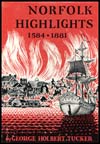Chapter 16
The Borough Church
All Episcopal churches in Norfolk are directly descended from the first Anglican church of Elizabeth River Parish "at Mr. Seawell's Pointe," begun in the late 1630s and completed, according to the records of Lower Norfolk County, by March 15, 1640/41.*
The church stood somewhere within the present western limits of the Norfolk Naval Station and continued in use for many years even though a "chapel of ease" was completed by 1641 farther down the Elizabeth River between Lamberts Point and what was later called Town Point in Norfolk. The chapel was erected for the convenience of the inhabitants of Lower Norfolk County who lived at a distance from the main church at Sewells Point.
Later, when Norfolk was laid out as a town in 1680-81, what is now St. Paul's Churchyard was set aside as a church site and burial ground. But no church was built there until after July 15, 1698, as a lot was granted on that date next to the present churchyard and there is no mention either of the church or the churchyard in the boundary designations.
Not more than a dozen families were living in Norfolk when it became the seat of Norfolk County in 1691, and those who did, no doubt, continued to use either the Sewells Point church or the "chapel of ease" nearer home. By 1693, however, the number of families in town had practically doubled, and by 1698 there were at least thirty private establishments in Norfolk. The time had come, therefore, for the erection of a church within the town, which was begun probably late in 1698 and completed by 1700, when Samuel Boush I presented a still-preserved London-wrought silver chalice "to the Parish Church of Norfolk Towne March 1700."
The church was of brick and timber construction and stood near City Hall Avenue in the present churchyard. It remained in use until after 1739, when the present St. Paul's was built. And it was in this first church that Colonel William Byrd II of Westover and his companions worshiped on March 3, 1728, when they were on their way to assist in the surveying of the boundary line between Virginia and North Carolina.
Byrd's entry in his "Secret History of the Dividing Line" deserves quoting: "This being Sunday we were edify'd at Church by Mr. Marston with a good sermon. People could not attend their devotion for staring at us, just as if we had come from China or Japan."
The present church, the southeast gable of which is marked with the date 1739 and the letters "S.B." in raised bricks, was handsomely fitted up, befitting the increasing prosperity of Norfolk, which had been elevated to the distinction of a borough in 1736. The raised initials in the gable have always been presumed to be those of Samuel Boush I, a great benefactor of the church and Norfolk's first mayor, who had died in 1736, but there is no definite proof that this is so.
Be that as it may, the 1739 church, which received many handsome pieces of testimonial silver, several of which are still preserved, continued in use until the burning of Norfolk in January of 1776 by the British and Virginia forces, at which time its walls were among the few structures left standing in the borough.
After the Revolution, an act of the Virginia Assembly in October of 1785 permitted the holding of a lottery to re-roof the fire-gutted building. Later, after the first Christ Church was built in 1800 across Church Street from the old church that was then without a congregation, the building was used for a time as Norfolk's first Baptist church, a racially mixed one.
In 1832, however, the Rev. Henry W. Ducachet of Christ Church and his congregation were responsible for the rehabilitation of the old church, at which time it was renamed St. Paul's.
* Editor's Note: The 1640/1641 notation reflects the difference between the Old Style calendar and the New Style, which England did not adopt until 1752. In the Old Style, New Year's was marked on March 25. So, January 1640 in the Old Style would be what we think of as January 1641.
Chapter
17
The Borough Churchyard
Norfolk Highlights 1584 - 1881

See the "Table of Contents" for links to every chapter in Norfolk Highlights 1584 - 1881 by George Holbert Tucker.
